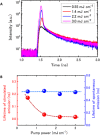Telecom-band lasing in single InP/InAs heterostructure nanowires at room temperature
- PMID: 30801006
- PMCID: PMC6386577
- DOI: 10.1126/sciadv.aat8896
Telecom-band lasing in single InP/InAs heterostructure nanowires at room temperature
Abstract
Telecom-band single nanowire lasers made by the bottom-up vapor-liquid-solid approach, which is technologically important in optical fiber communication systems, still remain challenging. Here, we report telecom-band single nanowire lasers operating at room temperature based on multi-quantum-disk InP/InAs heterostructure nanowires. Transmission electron microscopy studies show that highly uniform multi-quantum-disk InP/InAs structure is grown in InP nanowires by self-catalyzed vapor-liquid-solid mode using indium particle catalysts. Optical excitation of individual nanowires yielded lasing in telecom band operating at room temperature. We show the tunability of laser wavelength range in telecom band by modulating the thickness of single InAs quantum disks through quantum confinement along the axial direction. The demonstration of telecom-band single nanowire lasers operating at room temperature is a major step forward in providing practical integrable coherent light sources for optoelectronics and data communication.
Figures




References
-
- Schawlow A. L., Townes C. H., Infrared and optical masers. Phys. Rev. 112, 1940–1949 (1958).
-
- Maiman T. H., Stimulated optical radiation in ruby. Nature 187, 493–494 (1960).
-
- Choquette K. D., Hou H. Q., Vertical-cavity surface emitting lasers: Moving from research to manufacturing. Proc. IEEE 85, 1730–1739 (1997).
-
- Hill M. T., Oei Y.-S., Smalbrugge B., Zhu Y., de Vries T., van Veldhoven P. J., van Otten F. W. M., Eijkemans T. J., Turkiewicz J. P., de Waardt H., Geluk E. J., Kwon S.-H., Lee Y.-H., Nötzel R., Smit M. K., Lasing in metallic-coated nanocavities. Nat. Photonics 1, 589–594 (2007).
-
- Maslov A. V., Ning C.-Z., Size reduction of a semiconductor nanowire laser by using metal coating. Proc. Spie 6468, 64680I (2007).
LinkOut - more resources
Full Text Sources

